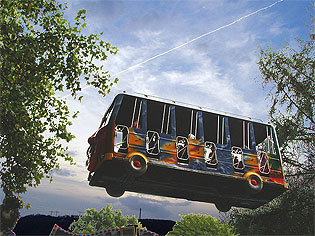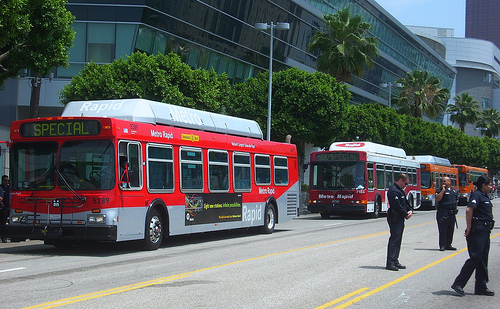 Image: Erich FerdinandIf you’re like most people, you navigate to work in the hazy fog of your early morning stupor. Autopilot. Imagine if one day your normal bus route was taken away and replaced with something utterly different. You’d probably be baffled, or pissed, or both.
Image: Erich FerdinandIf you’re like most people, you navigate to work in the hazy fog of your early morning stupor. Autopilot. Imagine if one day your normal bus route was taken away and replaced with something utterly different. You’d probably be baffled, or pissed, or both.
Well, that’s exactly what the brave folks at Tallahassee’s StarMetro did to surly commuters one morning this summer. After decades of buses tracing the same routes from the outskirts to downtown and back, planners took the old map, threw it in the garbage, and replaced it with something they thought would more efficiently connect workers with their jobs.
Emily Badger writes for The Atlantic Cities:
The result that morning was something like chaos. But over the next few weeks, riders settled into a system that serves them in a radically new way: It actually takes them where they need to go. All of the city’s previous routes went one place: downtown. But by 2005, just 14 percent of the region’s jobs were located there. And the results of a 2009 on-board survey showed that only 6.8 percent of StarMetro’s riders were trying to get there.
Despite the best efforts of urbanists to keep jobs downtown — and despite recent news that some companies are moving back into the city from the ‘burbs — the old blueprint has been dying a slow and painful death. Its roots date back to 1826 when economist Johann Heinrich von Thünen developed a model describing which crops should be grown where based on how much it cost, and how long it took, to get those crops to market. To make money, farmers had to sell their harvest in the city, so his schematic involved a series of concentric rings emanating from the city center, with dairy farms in the innermost ring (milk and cheese are heavy) and ranches on the farthest fringe (those future hamburgers can walk to town themselves).
Of course, our man von Thünen was writing during the days when things had to be hauled cross-country via oxcart. We’ve made some improvements to transportation since then, and agriculture has gone global. But we’ve stubbornly held to the idea that the market — and jobs — ought to be downtown. It’s not that a central business district is a bad idea; it’s just that the modern service economy demands that people work all over town. And it’s the suburbs that have seen the most dramatic job growth in recent years. Couple these factors with the fluidity of the labor market and you have a workforce that demands mobility.
For many people, that means driving a car, but rerouting transit systems to more closely mirror passengers’ actual travel patterns is a sensible way to reduce car dependence. It also has the benefit of greatly shortening rides for people who are dependent on transit.
That’s not to say StarMetro’s plan went off without a hitch. There are a few people who remain royally pissed off — witness the new Twitter account, @StarmetroFail. But on the whole, StarMetro seems to be working out the kinks. The new lines no longer resemble the starburst patten that characterizes so many mass transit systems. Instead, the map looks more like a plate covered with tangled spaghetti. (Really, that’s a compliment.)
Tallahassee may be the most recent city to scrap its old bus map for a sleeker, newer model, but here’s hoping it’s not the last. As Badger’s article points out, the Brookings Institution has singled out systems in Chicago, Atlanta, and Philadelphia as failing to give commuters the routes they need.
A little common sense might take these towns a long way. As StarMero senior planner Samuel Scheib told Badger, “I’m all for urbanization, I’m all for denser places. But the reality is that people need to get to work.”
Read the full Atlantic Cities story — with before and after maps of Tallahassee’s bus system — here.



